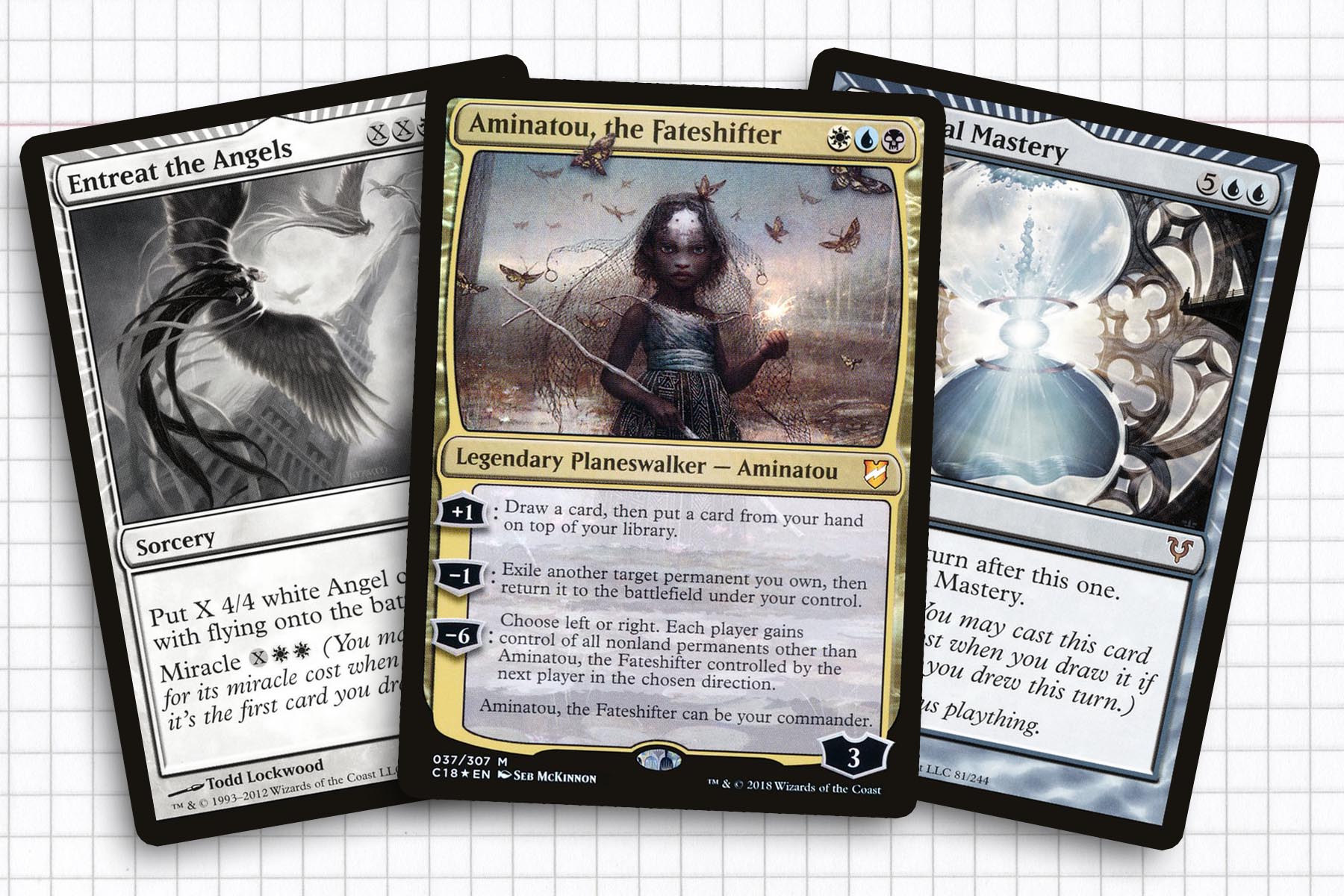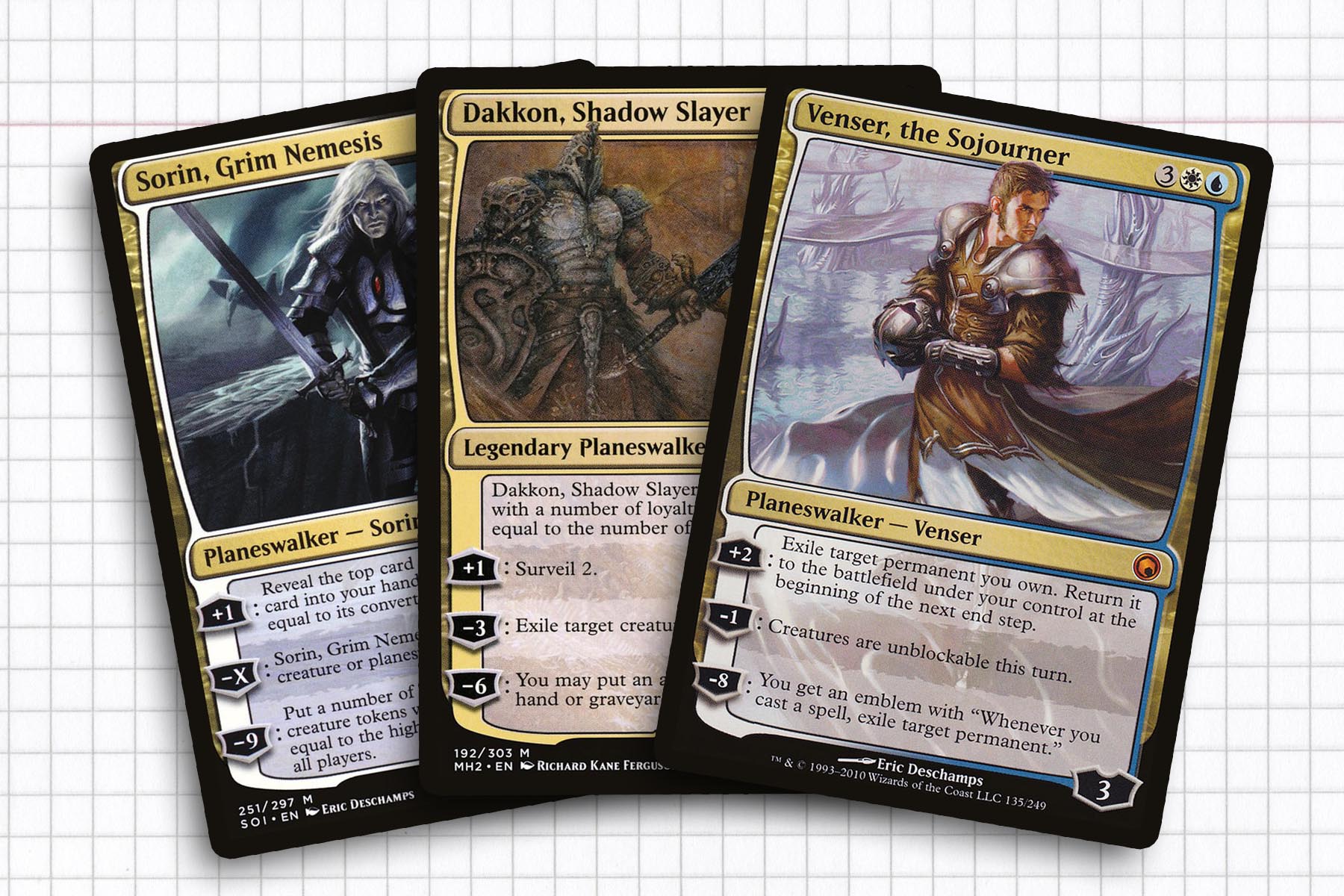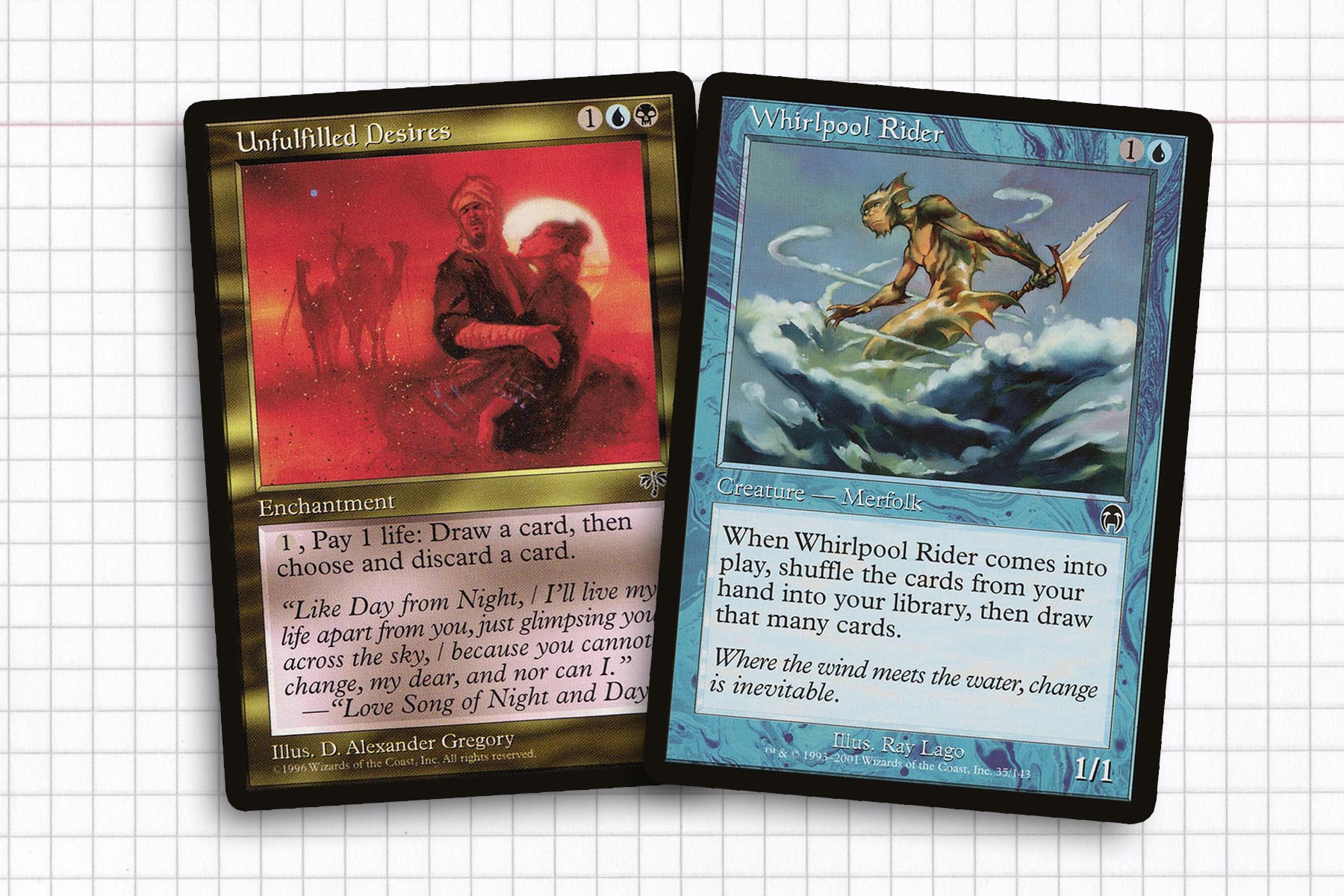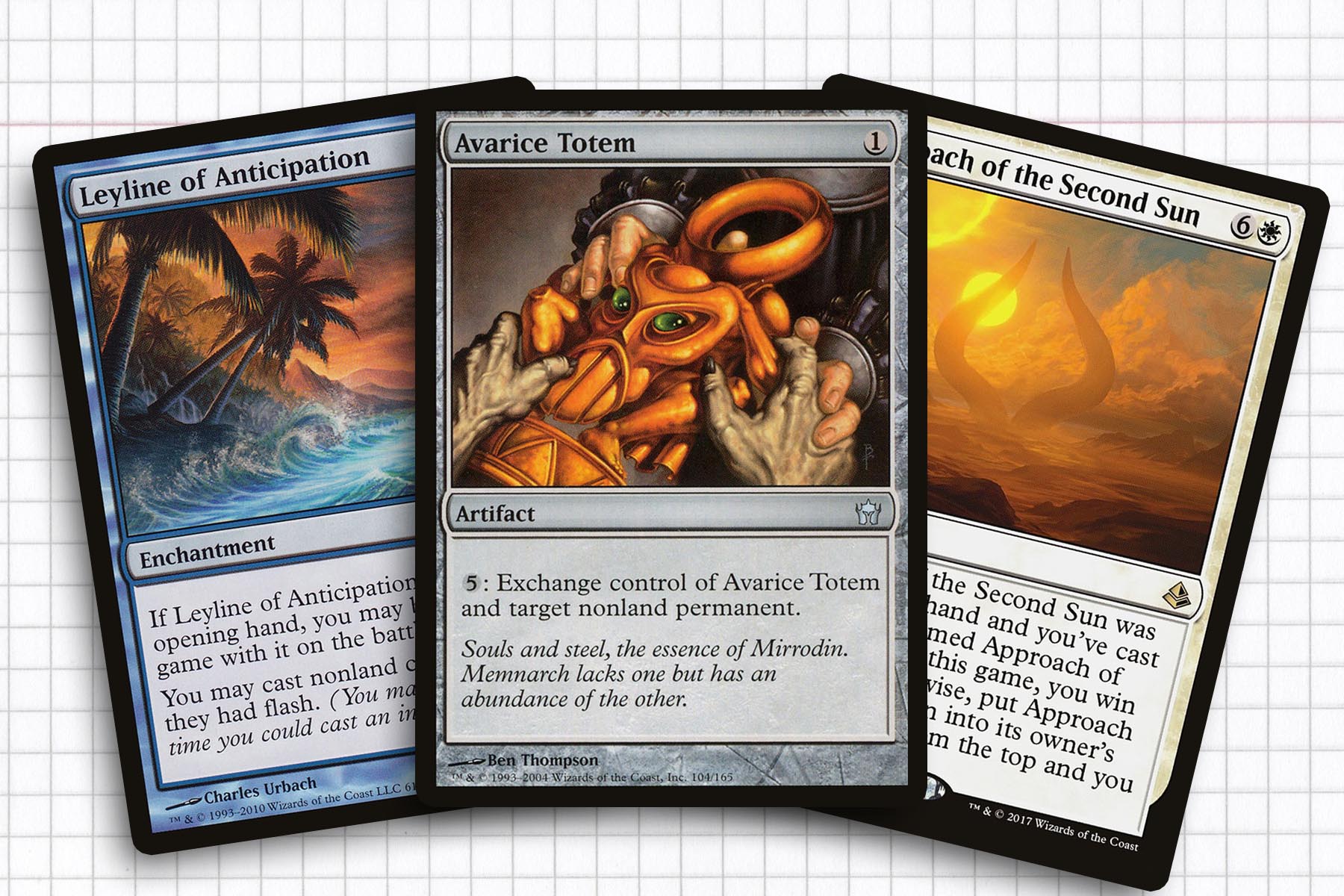Without necessarily meaning to, I have taken the mindset of intentionality highlighted by the Goblin Lore podcast to heart this year. Whereas in the past I felt like I was chasing trends and trying to keep up with each set as it was being released, last Fall I realized that the most constructive way to plan out my creative ventures was to start making a roadmap. I knew a good amount of 2022 would be highlighting decks that I have written about in the past, in an effort to provide a little bit more continuity.
With all that said, I knew that I was going to get around to today’s topic at some point this Summer. In light of some recent games I’ve played and the fact that Aminatou, the Fateshifter is being reprinted in Double Masters 2022, I felt it was a incredible time to discuss where this deck has gone since I last spoke about it in early 2019. My only reservation is that because I spoke about Saheeli, the Gifted and Brudiclad, Telchor Engineer in my last two installments, I’m worried that instead of asking “Izzet June?” people will ask “is it 2018?”
The deck has come a long way since that first iteration. In some ways, it helped me to understand what kind of Commander games I enjoy and what kind of mechanics I find don’t optimize the fun for me. This week, we’ll highlight the good and bad of the deck’s history and by day’s end, discuss one of the greatest Commander moments I have ever experienced, which happened while playing this deck.
Commander: Aminatou, the Fateshifter
Creatures: Cryptic Annelid, Deepglow Skate, Doom Whisperer, Elite Guardmage, Enigma Sphinx, Ethereal Investigator, Glasspool Mimic, Lavinia of the Tenth, Minn, Wily Illusionist, Mistmeadow Witch, Psychosis Crawler, Rakshasa Debaser, Solemn Simulacrum, Soulherder, Suncleanser, Thieving Amalgam, Vendilion Clique, Wernog, Rider’s Chaplain, Whirlpool Rider
Planeswalkers: Dakkon, Shadow Slayer, Jace, Arcane Strategist, Liliana Vess, Sorin, Grim Nemesis, Teferi, Who Slows the Sunset, Venser, the Sojourner
Artifacts: Avarice Totem, Commander’s Sphere, Fellwar Stone, Imposter Mech, Mishra’s Bauble, Scroll of Fate, Sensei’s Divining Top, The Chain Veil
Enchantments: Counterbalance, Eyes Everywhere, Hedron Alignment, Leyline of Anticipation, Mastery of the Unseen, Oath of Gideon, Oath of Jace, Oath of Teferi, Primordial Mist, Puca’s Mischief, Search for Azcanta, Soothsaying, Thought Reflection, Unfulfilled Desires
Instants: Ancient Excavation, Commit // Memory, Consider, Eerie Interlude, Faithful Mending, Otherworldly Gaze, Scout’s Warning, Sudden Substitution, Teferi’s Ageless Insight, Teferi’s Protection, Teferi’s Time Twist
Sorceries: Akroma’s Vengeance, Aminatou’s Augury, Approach of the Second Sun, Farewell, Inevitable Betrayal, Time Warp
Lands: 4 Island, 3 Plains, 2 Swamp, Ash Barrens, Bad River, Barren Moor, Blasted Landscape, Command Tower, Desert of the Glorified, Desert of the Mindful, Desert of the True, Drifting Meadow, Drowned Catacomb, Flood Plain, Forge of Heroes, Glacial Floodplain, Glacial Fortress, Ice Tunnel, Isolated Chapel, Lonely Sandbar, Polluted Mire, Raffine’s Tower, Remote Isle, Secluded Steppe, Snowfield Sinkhole, Temple of Deceit, Temple of Enlightenment, Temple of Silence, Underdark Rift

A Lack of Miracles
The biggest paradigm shift within this deck since my last discussion on it was the moving away from the manifest and miracles mechanics. I love manifest, so it can still be seen with Mastery of the Unseen, but the auras that manifested cards from the top of my library became something that wasn’t very fulfilling and often didn’t pay off in the ways that I intended. This did mean the loss of Inverter of Truth, which pains me even to this day; but after reflecting on it, manifest proved to be a contributor to the gameplay within the deck being pulled in far too many different directions.
Moving away from miracles, on the other hand, came from the fact that I didn’t really enjoy managing the miracles in my hand in combination with Aminatou’s plus ability. What was meant to be a way of throwing haymakers to fundamentally shift the game in my direction, proved to be something that was taking up space within the deck, wasting entire turns of multiple games at sorcery speed. Once I was no longer trying to support Devastation Tide, Entreat the Angels, Temporal Mastery, and Terminus, it allowed me to turn my attention towards some of the other themes that I was finding a little bit more interesting to fine tune.
After gaining momentum, the deck began to focus on drawing-matters and the superfriends synergies, making Jace, Arcane Strategist a card I was not only entertaining, but actively benefiting from on a regular basis. And while top deck matters cards like Sensei’s Divining Top, Sorin, Grim Nemesis, and Soothsaying remained in the deck list, they were no longer mentally taxing to use and allowed for faster game play, as I no longer had to do the “miracle math.”

So This is Superfriends?
While this is certainly my most planeswalker-friendly deck, I would hate to give off the impression that it is a superfriends deck. Yes, we have Deepglow Skate and The Chain Veil, but they exist more to support Aminatou than to hoping to highlight any of the other planeswalkers. That said, including planeswalkers can be a lot easier to build around in a deck with a planeswalker general; you know that the Oath of Gideon or Oath of Teferi is going to get some use, because you’re more than likely going to have a planeswalker in play at some point during the game.
This deck has come a long way since only housing Liliana Vess, Sorin, Grim Nemesis, and Venser, the Sojourner previously. But the modular nature of planeswalkers makes them great toolbox cards, drawing extra cards, tutoring cards, or acting as removal. Heck, the more I use Dakkon, Shadow Slayer, the more I realize just how versatile he is.
Aminatou obviously feeds into the planeswalker support, because she can reset them with her minus ability and in turn, Oath of Teferi or Venser, the Sojourner can reset her. Then there is The Chain Veil, which often needs to be thought of as an eight-mana spell, a card that can fundamentally change how players interact with your deck, because your turns take on such drastic new decision trees. With the backing of Time Warp, I finally have the option of considering planeswalker ultimates like Liliana Vess and Sorin, Grim Nemesis, truly twisting the game firmly in my direction.

Cantrips and Enablers
Once I was no longer beholden to miracles, I started to double down on extra draw effects. While I am an advocate for cycling lands to spice up mana bases and sneak extra draw effects in, this is the only one that I own where I went for the full suite of Ash Barrens, Blasted Landscape, Desert of the Glorified, Desert of the Mindful, Desert of the True, Drifting Meadow, Lonely Sandbar, Polluted Mire, Remote Isle, and Secluded Steppe. This came from the desire to never have my hand remain stagnant and keep my options open throughout the game.
A new addition that has really helped to jump start my games has been Wernog, Rider’s Chaplain, the Universe Within reprint of Will the Wise from the Stranger Things Secret Lair, most players on turn two or three will gladly take the free clue token and that can keep us drawing live more often than we used to. When our draws are doubled with Thought Reflection or Teferi’s Ageless Insight, hidden gem Unfulfilled Desires goes from being a relic of the era of the deck where I thought the deck needed to also support some reanimator strategies to a bonafide draw engine.
One of the most jarring card substitutions came when I started comparing Riverwise Augur vs. Whirlpool Rider. The Augur had basically been a mainstay of the deck for its entire existence, mostly feeding off of how powerful the general’s plus ability was in combination with the fact that Brainstorm is a historically powerful card. The deciding factor ultimately became just how lacking the top deck manipulation was in the face of a low amount of shuffle effects. Instead, Whirlpool Rider will often provide me with a new hand in the face of one that is not actively doing something in the game, and in even better context when used in tandem with Thought Reflection or Teferi’s Ageless Insight, means that I am gaining cards in my hand and not setting up what could be dead draws.

Aminatou Has No Way to Win
A core tenet of this deck, since almost the beginning, was the strong desire to acquire other players cards for my own use on a regular basis. This wasn’t something that I felt was strongly reflected in previous drafts, but has since become something that recent cards like Inevitable Betrayal and Impostor Mech have really empowered. These cards really helped me to craft a Bribery-style deck that didn’t solely rely on heavy Clone-effects like a deck Lazav, Dimir Mastermind often does.
While I assumed that Puca’s Mischief was going to lead the charge on steal effects, it actually turns out that Avarice Totem often proves to be one of the best cards in the deck. When I’m not blinking the Totem, five mana can feel like a lot of mana to swap cards. But in some ways, I love that it is a cumbersome amount of mana, because it means that taking back the card I stole may completely invalidate an entire turn on behalf of my opponent.
Of course, not every victory needs to be deceptive. All of the card draw previously mentioned feeds into the most blatant enabler, Approach of the Second, which I have cast in back-to-back turns twice this year already. And of course, 2012 Commander staple Psychosis Crawler pulls a lot of weight to win games in a pinch as well.
This overall commitment to wanting to use my opponents’ decks against them is also what resulted in what might be the greatest Commander achievement I have ever done. Late last year, I found myself in the last three remaining players of a game where one of my opponents had animated their Dark Depths as a last-ditch effort to take out a tapped out “archenemy.” After they had removed that player from the game, I flashed in Suncleanser, via my Leyline of Anticipation, and I removed all the counters from Dark Depths. I then traded the Marit Lage token with my Avarice Totem and the player scooped in response.
Closing Thoughts
While this deck doesn’t inspire the same kind of pithy discussions that I may have covered earlier in the year, I do think that there are a lot of lessons that can be taken from the evolution of this deck. As always, I think it’s good to learn that your first draft of a deck is not always going to be emblematic of where the deck goes in the future. But also I think that experimenting with the limits of a general can result in a deck evolving from something that you enjoy putting together after buying a precon to something that you actively review Scryfall in your free time, trying to personalize.
Obviously miracles were just not my thing. And I wanted a Wheel of Fortune style deck that wasn’t using all of the same staples, which I was able to address by simply not being in Red. But I think the most important thing was that Aminatou fed into this fun archetype that I often find myself ending up in, where I match the power level to the rest of the table by simply using the decks around me against their owners.
Next time, we will be capping off what I am now calling the “Summer of 2018,” by discussing the legendary creatures of Commander 2018. This means we will be touching on another suite of planeswalker commanders and the mere creatures amongst their ranks. Thanks for reading.
Ryan Sainio is a Graphic Designer who writes about EDH and the EDH community. He has been playing Magic: the Gathering since 7th Edition in 2002 and values flavorful and fun gameplay over competitively optimized decks.

